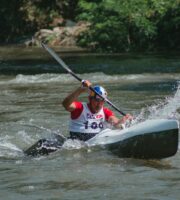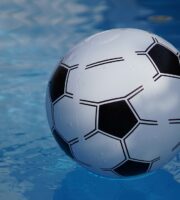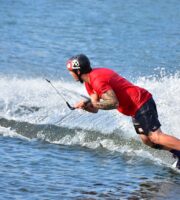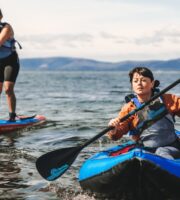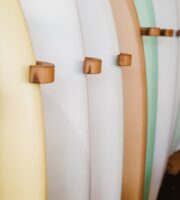If this is your first time coming to a wake park or trying to learn how to wakeboard behind the boat, you first need to practice a little on the ground and determine which foot is your leading foot. There is a simple exercise for this. Stand up straight and ask someone to push you slightly from the back (of course, let it be a person you trust). The leg that will instinctively be in front will be the leading leg.
Determined with the leading leg, you can already try to get up on a wakeboard on the water. For the first time it is better to try to get up on a wakeboard behind the boat or on a reversible winch and necessarily with an instructor, because the start on a circular winch is quite abrupt, and to master it from scratch may not be as easy as it seems from the outside.
Once you are in the water, lie on your back and place your wakeboard perpendicular to the movement. Tighten or lace your bindings firmly so you don’t accidentally jump out of them as you skate. Choose, put on and adjust the vest so that you feel comfortable in it and it does not restrict your movement. Once you are in the water, lie on your back and position your wakeboard perpendicular to the start direction. The halyard should rest on top of the board. Grasp the handle with both hands, arms straight out and do not bend. Keep your knees pressed against your chest. When you are ready to start, give a special sign to the boat pilot or the winch operator – lift the halyard up slightly and lower it – to start moving. When the halyard straightens and you begin to be pulled forward, stay in a semi-seated position while you are pushed out of the water onto the board. Stand up slowly, as if you had been squatting for a long time. Don’t fully straighten up too soon until you are pulled out of the water.
As soon as the boat or winch pushes you out of the water, lightly shift your body weight to the rear leg and the wakeboard turns toward the boat. The front of the board now faces the boat. Your knees are slightly bent, your shoulders and hips are in line with the wakeboard, and your arms are straight. Lean back slightly so that your hips are over your front foot and your shoulders are over your back foot. Try to keep your balance at all times and enjoy the process of riding.
You certainly have seen many videos on Youtube where riders do different tricks on a wakeboard, both when riding on the winch and behind the boat. However, not all riders like to do stunts. You can just glide across the water and enjoy the experience. Speed, splashing water, wind in the face – already a good combination of new experiences for those who first got on a board. Well, for those who are already confident on a wakeboard and crave more extreme we can offer to learn how to do various tricks on a wakeboard: waterboarding, jumps, rotations, etc. (read about this in the following articles).
Mistakes of beginner wakeboarders
Of course, trying to get on a wakeboard is not without mistakes at first. When riding a wakeboard you should always remember to stay safe and develop a sense of balance. It’s necessary when the boat pushes the rider out of the water as well as when the rider is already on the water. Developing a sense of balance is not an easy task and special exercises such as the famous “swallow” or balance-board will help you.
Other typical mistakes that wakeboarders make are:
- bend their arms and pull the halyard towards themselves, while the boat itself should push the wakeboard out of the water;
- Straightening out completely before the boat pushes the wakeboard out of the water;
- Excessively trying to lift the board over the water (only the front of the board should be lifted)
There are many different ways to start on a wakeboard. For example, you can start not only from lying down, but also from sitting or even standing. Another way is to start not from the water, but, for example, by diving from the pier. But these ways are more traumatic and are suitable for more experienced riders. We advise for beginners to start riding a wakeboard from the water, from prone position. This way you can avoid unnecessary strain on your knees and back and not harm yourself and others around you.
What else you need to keep in mind
If you spend a lot of time in the water in the sun, do not forget about personal comfort and safety. Always wear a life jacket when out on the water. It cushions possible hits against the water and, if necessary, slightly supports you on the water if you fall. It is also advisable to wear a wetsuit or a wetsuit, depending on the weather. A lycra wetsuit will protect you from sunburn in warm weather, and a neoprene wetsuit will protect you from hypothermia in cold weather.
